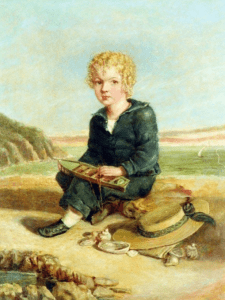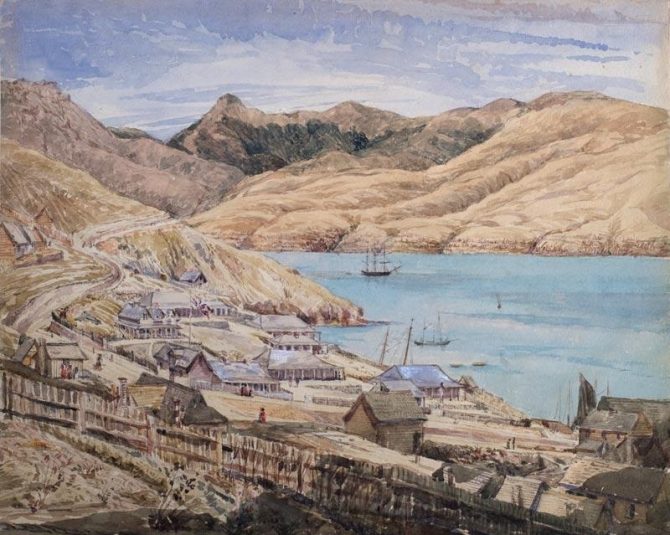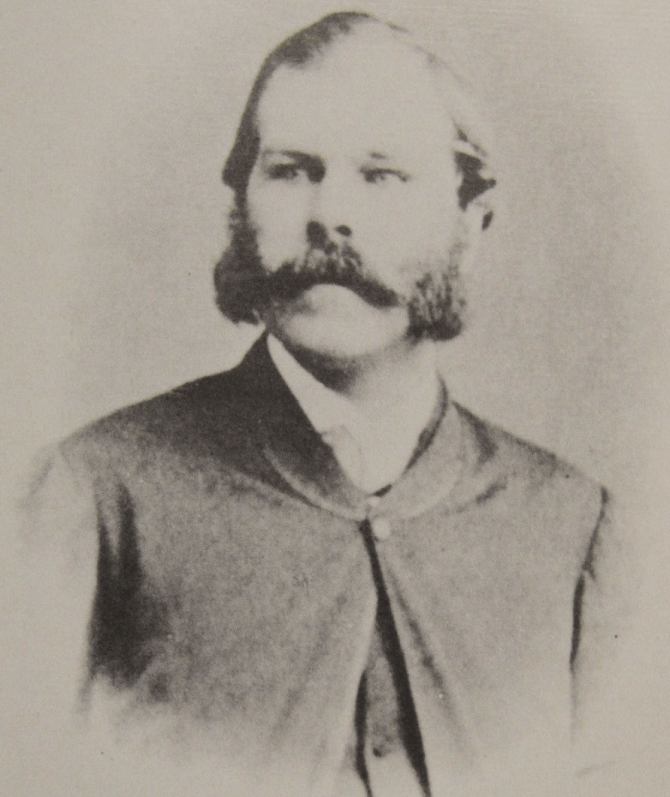What's a cis-het male British settler to do? You've either been out here since the 1840s, surveying and exploring, or you've arrived fairly recently on a Canterbury Association ship. You're thinking you might be ready to settle down, but you really need a young lady of the right class to ask to be your bride. This is where the Misses Townsend come in! The family arrived on the Cressy - parents James and Alicia, six daughters, two sons and a nephew - in 1850. By 1857 a range of prominent early Cantabrians had each married a Miss Townsend.
Charlotte Godley, the ultimate chronicler of early Canterbury, describes their romantic appeal at a grand ball in one of the Lyttelton Emigration Barracks buildings with the excitement of a Jane Austen mama:
'All the six Miss Townsends came except Sara's friend the eldest, and were in fact, except for three or four, all our stock of young ladies.'
Godley, 169
They were also a subject of rumour and gossip:
They keep a sort of open house, at tea time, for young gentlemen, who are very glad, here, to have a respectable place to spend their evenings in, and of course when anyone was seen to go there two or three times, there was directly a report of a wedding,
Godley, 251
Charlotte also records this story about an abortive marriage proposal from James Stuart-Wortley to Marcia:
[Stuart-Wortley] has had a worse accident [than breaking his collar bone] lately, by proposing to the youngest but one of the Miss Townsends, when I am sure he was not a bit in love, in any good sense, and he never even liked the family, bit I need not go into details. He is nineteen, or perhaps just twenty, and she sixteen, so it is pretty silly, without money, or any compensating degree of love. I suspect it will end in nothing.
Godley, 319
Regrettably, they are largely defined by their husbands. I haven't found any images of them (and struggled for their husbands, but the ones I've found do have excellent facial hair), and their individual voices don't really survive. Both Charotte Godley and Edward Ward tend to lump them together:
Met William Deans and three Miss Townsends. One of them would make a good Mrs Deans.
It can't always have been fun being one of six sisters. They seem to have been quite musical, as demonstrated by another quote from Edward Ward, although why he is thinking about how much the sister of his fiancée - Mary King - looks like one of the Misses Townsend I do not know...
The Miss Townsends keep up the music. One of them, I remarked today, very like Jane King—which set my thoughts agoing much too hard during the sermon to be bored by its dreariness.
Even though Mary King never married Edward Ward - he and his brother Henry drowned in mid-1851 - she married one of his cousins, thus relating her to the two Townsend sisters who each married one of Edward's brothers.
Mary (1821? - 1869)
Mary was either the eldest or second eldest (the age on her headstone suggests the former, what people say about her suggests the latter), born around in 1821, probably in London (her parents had been married in Croydon in 1814). She trained as an artist and painted some of the earliest views of Lyttelton. She also painted portraits, including the one of young John Arthur Godley seen above.
On 20th November 1851 she married early Lyttelton stalwart Dr William Donald at Holy Trinity. They had 3 boys - one who died young - and a daughter. Mary died on New Year's Eve 1869 and is buried in Lyttelton Cemetery. There was a memorial window to her in Holy Trinity Lyttelton which records that, "this woman was full of good works and alms deeds, which she did". I believe this memorial survived the earthquakes.
Alicia (1827 - 1909)
Alicia was born in Wandsworth, London in 1827. Her husband was Canterbury surveyor, Charles Torlesse. They married at St Michael's, Christchurch on 27 December 1851, and had four (possibly 5?) children. The family were early settlers of Rangiora and Fernside. Charles' health deteriorated, and the family returned to the UK in 1865 where Charles died the following year.
As far as I can tell the widowed Alicia then spent time in both Rangiora and the UK. I haven't tracked down her exact movements, but she does appear in the UK census, and Canterbury newspapers. In the 1871 census from Ancestry, she is staying with her sister Margaret Cooke in London and is described as a 'farmer's widow in New Zealand'.
In 1881 she is head of a household in the UK and described this time as a landowner in New Zealand. Presumably, she must have done the sea crossing a number of times, showing that emigrating to the antipodes in the Victorian era wasn't a one way journey - if you could afford it.
In 1901 she is 73 and living on the Isle of Wight, where she died on 18th May 1909. She is buried with her husband in Stoke Nayland, Suffolk.
Frances (1830? - 1889)
Frances was presumably born in London. According to the MacDonald Dictionary she was the eldest Townsend sister and her death notice supports this, however her headstone in Barbadoes Street Cemetery gives 1830 as her birth year. So far I haven't been able to find birth records for Frances or Mary in order to confirm who was eldest.
Her husband was William John Warburton Hamilton and they were married on 6th November 1855 also at St Michael's. They had 7 children. In 1873 their second daughter Rose Philippa died aged 10 years and 8 months. Frances died in 1889, her last address being 21 Latimer Square.
Priscilla (1831 - 1860)
Again, I presume Priscilla was born in London. On 28th October 1852 she married John Cowell Boys at Holy Trinity Lyttelton. She died in Rangiora after the birth of her third child on 17 May 1860, and I assume she is buried in the Anglican Cemetery there. Sadly she is the most elusive of the sisters.
Marcia (1835 - 1915)
Marcia was born in St Pancras, London. Her eminent husband was John Hamilton Ward, a younger brother of Edward Ward. They were married on 15 April 1857 at St Bartholomew's, Kaiapoi, and had ten children.
The family moved to Auckland in 1871 and later in the decade they returned to the UK, settling first in Battersea, London, and then in Worthing on the Sussex coast. I rather enjoy that in the 1911 census John describes himself as a 'retired colonist'. Marcia died on the 25th July 1915 and is buried in Worthing Broadwater Cemetery.
Margaret (1837 - 1912)
Margaret was born in Marylebone, London. Her first husband was Crosbie Ward, who she married at the Temporary Church, Lyttelton on 13th January 1857. Crosbie was the brother of Edward and John Hamilton. He had come to New Zealand after Edward and Henry drowned in order to look after their affairs, and John who was only 17.
They had maybe 2 children and spent time back in Ireland in the early 1860s. Crosbie died in 1867. The following year Margaret was back in the UK and married John George Cooke, who had served with the British Army in Taranaki. They settled in London, living at a house called Killinchy (where the Ward Brothers were from) in Balham. Margaret died in 1912 and is buried in Brompton Cemetery.
To sum up
While all the Misses Townsends are elusive to some extent, they do shine a light on early Canterbury and the family connections of the settlement. They are representative of well-to-do early colonists who stayed and also those who returned to the UK.







Add a comment to: ‘All our stock of young ladies’ – The Misses Townsend